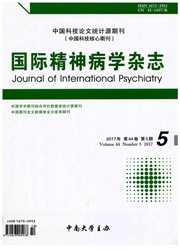

 中文摘要:
中文摘要:
目的研究重大创伤幸存者情绪自动加工对其认知的影响。方法比较10名重大创伤幸存者在创伤后一个月内与10名健康对照者完成闽上和阈下情绪任务的行为学和脑电结果。结果在阈上任务中,当启动刺激为正性或负性情绪图片时,创伤组平均反应时间长于对照组;但两组间反应正确率无明显差异。ERPs结果显示,阈上任务中创伤组P2潜伏期明显长于对照组,波幅无明显差异。结论大多数个体在经历重大创伤后,随时间推移其情绪加工及认知判断均渐趋向正常,P2成分可能是判断个体是否完全恢复的一个敏感的指标。
 英文摘要:
英文摘要:
Objective trauma survivors. Methods The aim of this study was to explore the influences of emotion on 10 survivors who experienced major trauma during one month and cognition in major 10 healthy controls were completed sub - threshold and supra - threshold emotion tasks, their behavior responses and electrophysiological data were recorded. Results Giving positive or negative emotion pictures as the priming stimulus, the average reaction time of survivors were longer than that of controls in supra - threshold emotion task, but the accuracy made no differences between the two groups. P2 latencies were prolonged in survivors, and P2 amplitudes had no significant differences between survivors and controls. Conclusions Emotion process and cognition judgment of most survivors are trending to normal after major trauma. P2 element is likely to be a sensitive marker to judge whether the individual recover completely.
 同期刊论文项目
同期刊论文项目
 同项目期刊论文
同项目期刊论文
 Abnormalities of cortical-limbic-cerebellar white matter networks may contribute to treatment-resist
Abnormalities of cortical-limbic-cerebellar white matter networks may contribute to treatment-resist White matter abnormalities in adolescents with generalized anxiety disorder: a diffusion tensor imag
White matter abnormalities in adolescents with generalized anxiety disorder: a diffusion tensor imag White-matter density abnormalities in depressive patients with and without childhood neglect: A voxe
White-matter density abnormalities in depressive patients with and without childhood neglect: A voxe Abnormal baseline brain activity in posttraumatic stress disorder: A resting-state functional magnet
Abnormal baseline brain activity in posttraumatic stress disorder: A resting-state functional magnet Different white matter abnormalities between the first-episode, treatment-naive patients with posttr
Different white matter abnormalities between the first-episode, treatment-naive patients with posttr Course-dependent response of brain functional alterations in men with acute and chronic post-traumat
Course-dependent response of brain functional alterations in men with acute and chronic post-traumat Abnormal cerebellum density in victims of rape with post-traumatic stress disorder: Voxel-based anal
Abnormal cerebellum density in victims of rape with post-traumatic stress disorder: Voxel-based anal Validity of the Chinese version Mood Disorder Questionnaire (MDQ) and the optimal cutoff screening b
Validity of the Chinese version Mood Disorder Questionnaire (MDQ) and the optimal cutoff screening b High-frequency rTMS treatment increases left prefrontal myo-inositol in young patients with treatmen
High-frequency rTMS treatment increases left prefrontal myo-inositol in young patients with treatmen Abnormal grey matter in victims of rape with PTSD in Mainland China: a voxel-based morphometry study
Abnormal grey matter in victims of rape with PTSD in Mainland China: a voxel-based morphometry study Validity of the 32-item Hypomania Checklist (HCL-32) in a clinical sample with mood disorders in Chi
Validity of the 32-item Hypomania Checklist (HCL-32) in a clinical sample with mood disorders in Chi Altered resting-state functional connectivity of thalamus in earthquake-induced posttraumatic stress
Altered resting-state functional connectivity of thalamus in earthquake-induced posttraumatic stress Dynamic Functional Connectomics Signatures for Characterization and Differentiation of PTSD Patients
Dynamic Functional Connectomics Signatures for Characterization and Differentiation of PTSD Patients Acute stress enhances contact dermatitis by promoting nuclear factor-kappa B DNA-binding activity an
Acute stress enhances contact dermatitis by promoting nuclear factor-kappa B DNA-binding activity an Increased regional homogeneity in internet addiction disorder: a resting state functional magnetic r
Increased regional homogeneity in internet addiction disorder: a resting state functional magnetic r Psychopathological, biological, and neuroimaging characterization of posttraumatic stress disorder i
Psychopathological, biological, and neuroimaging characterization of posttraumatic stress disorder i Influence and interaction of genetic polymorphisms in serotonin systems and life stress on antidepre
Influence and interaction of genetic polymorphisms in serotonin systems and life stress on antidepre High-frequency rTMS treatment increases white matter FA in the left middle frontal gyrus in young pa
High-frequency rTMS treatment increases white matter FA in the left middle frontal gyrus in young pa 期刊信息
期刊信息
